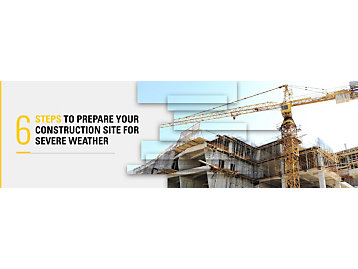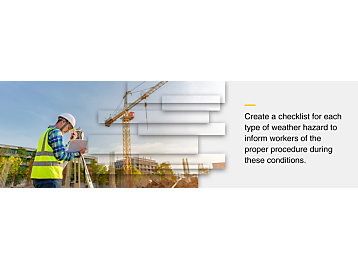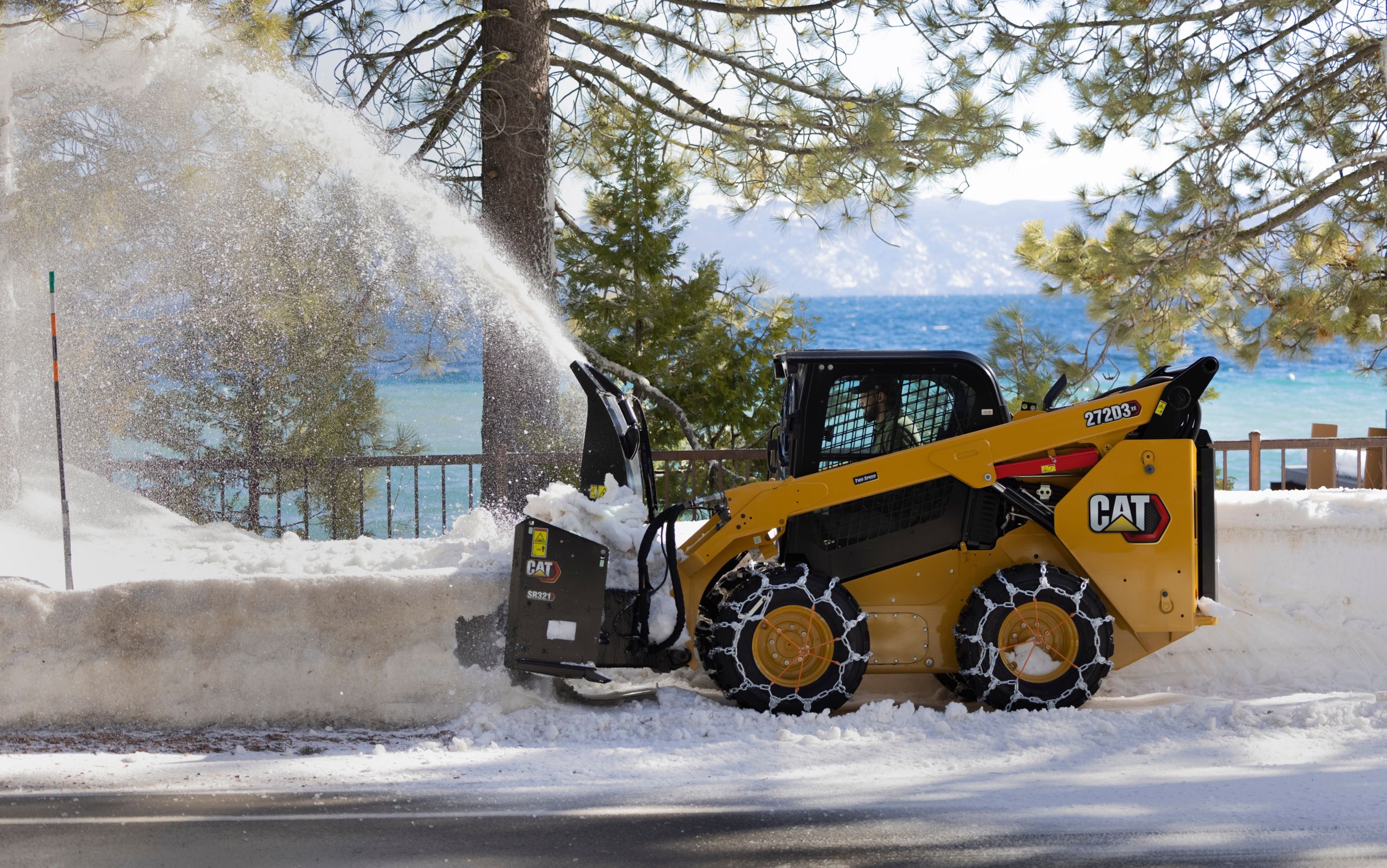

Sign In
Welcome! Sign In to personalize your Cat.com experience
If you already have an existing account with another Cat App, you can use the same account to sign in here
Register Now
One Account. All of Cat.
Your Caterpillar account is the single account you use to log in to select services and applications we offer. Shop for parts and machines online, manage your fleet, go mobile, and more.
Account Information
Site Settings
Security
Author: Small Business Expert | January 16, 2023 | Topic: Used Equipment

Heavy rain, lightning, heat and strong winds can all pose risks to your construction equipment and employees, leading to costly repairs, damages and a backed-up schedule.
Taking precautions for predicted or sudden severe weather changes can ensure a safe environment and reduce the impact on your project while you recover from the storm. Here, we'll discuss how to prepare your job site for severe weather and how to keep your employees and equipment safe.
The Importance of Weather Awareness
Severe weather can impact your construction project's equipment, workforce, schedule and budget. Heavy rains can cause flooding and erosion, while storms and winds can create unstable ground conditions. A severe weather plan for construction companies starts with weather awareness. It's important to regularly check the weather forecasts in your area. This precaution can give you enough time to take preventative measures before an impending storm or heat wave strikes.
Even last-minute construction site preparations can save your employees and equipment from injury and damage. Likewise, preparedness can prevent loss of productivity if your project becomes pushed back due to severe damage or flooding. Having a documented and practiced plan in place can help you avoid losing important materials, risking your workers' health or starting your project over.
Types of Severe Weather Risks on Construction Sites
Weather forecasts help predict the most severe weather conditions, but sometimes, they can come with little notice and create dangerous situations on your job site. Preparing your construction site for severe weather involves planning for any type of weather at any moment, such as:
Hurricanes
While hurricanes are often anticipated and allow for preparation, they can be extremely destructive. If a hurricane hits your construction site, it can face high winds, flooding, mud buildup and severe damage. These tropical storms can change suddenly, so have a plan to protect glass surfaces and electrical equipment. Secure any loose items indoors or tie them down to prevent them from getting blown away.
High Winds
High winds can result from storms, but they can also occur on their own without warning. Strong winds can lead to project delays and cause significant damage by toppling your equipment over or causing flying debris to crash into your equipment. Wind damage can also affect roof coverings, walls, frameworks and other materials you've partially built on your construction site.
Heavy Rain
Heavy rainfall can cause water damage and flooding to your site or equipment, particularly if you still have buildings under construction. If your construction site does not have proper drainage systems, these rains can flood an area and set your project back. Heavy rain can also seep into unfinished door and window openings or get into the electrical components of your equipment and ruin them.
Severe Heat
High temperatures can cause heat exhaustion or heat stroke in your employees. Construction equipment already creates a heat output, making strenuous construction jobs even more difficult when the climate is hot. Heat illness can affect your operators on your equipment, especially if a sudden heat wave comes and your workers do not have time to acclimate to the temperature. It's important to keep your employees and equipment cool during summer.
Thunderstorms, Lightning and Hail
Thunderstorms can create many hazards, including lightning, hail, flooding and strong winds. Always review your daily work activities and listen for weather reports predicting thunderstorms and seek shelter when needed.
Cold, Ice and Snow
As with heat, freezing temperatures can damage your equipment and affect your diesel engines. Cold temperatures make oil move slower and cause your engines to work harder. Snowstorms can also damage your equipment by freezing components, blocking airflow or burying your machinery under a heavy pile of snow.
It's important to winterize your equipment when working in cold climates so you can continue your operations. Additionally, icy conditions can create frostbite and hypothermia risks to your employees. Ensure your workers have the proper attire and equipment to stay warm and safe.
6 Steps to Prepare Your Construction Site for Severe Weather
When preparing your job site for severe weather, remember to keep your employees and equipment safe. Also know that the steps you take can change depending on the weather you're preparing for and the type of construction site you're working on. Here are six general tips to prepare your construction site for severe weather.
1. Plan Ahead
Create a detailed plan that accounts for every type of severe weather damage. Know what type of climate is common in your construction site's location, as this can help predict future weather patterns and give you more time to prepare. For instance, if your job site is in an area that frequently gets hurricanes, create a storm preparedness plan and evaluate any site-specific risks.
2. Monitor and Notify
Always monitor the weather throughout the day while on the construction site. If you hear or see a severe weather warning, notify all employees of their next steps or if they need to evacuate the area. Ensure all your workers know and understand your severe weather protection plans.
3. Secure Materials
To prepare your construction site for severe weather, secure your equipment and materials before a storm comes. High winds can pick up loose materials and throw them around your job site, causing breakage and excess debris that can put your project behind.
Secure your materials by tying them down or using sandbags to keep them in place, including:
- Equipment
- Temporary structures
- Signage
- Dumpsters
- Portable bathrooms
Board up windows and move smaller items, such as trash bins, indoors until the storm passes.
4. Create a Checklist
A severe weather checklist can make preparing for an incoming storm or high winds more efficient. Create a checklist for each type of weather hazard to inform workers of the proper procedure during these conditions. Here are some steps you'll want to include:
- Disconnect power generators and gas and water connections
- Cover all excavated holes to prevent flooding
- Close up open doorways with plywood to prevent damage
- Protect important documents, such as blueprints and contracts
- Identify nearby shelter
- Check water pumps to prevent flooding
- Prevent drain blockages so water can drain
- Place filters over drains to protect them from getting clogged

5. Stock up on Emergency Supplies
As you might prepare your home for an incoming hurricane, you should also protect your construction site by having emergency supplies on hand during severe weather conditions. For instance, a storm could knock out your power, so keep flashlights on hand. A heat wave could cause illness to your workers, so have plenty of water, food and shade on your site. Lastly, always have first-aid kits nearby in case of injury.
6. Plan for Delays
Heavy rain or high winds may drag items onto your construction site that weren't there before. Be prepared for project delays, as unpredictable weather can significantly set your schedule back. Set aside enough time to safely remove water and debris before bringing your construction team back onto the site. With checklists and weather plans, you can reduce project delays and get your site back on track shortly after a storm.
Recovering From Severe Weather
Though most extreme weather conditions are often preceded by warnings, sometimes, there may be little to no warning. Always conduct a post-storm evaluation to assess any serious damage or losses to your equipment or structures and determine if you need to make any reports or claims.
Once you know it's safe to begin working again, assign a team of workers to begin the cleanup process. Notify workers of broken glass, live electrical wires, leaking fuel tanks or flammable liquids. If your equipment happens to be damaged beyond repair, consider renting a replacement or buying used equipment to finish your project and stay on schedule.
Shop Used Equipment From Your Local Cat® Dealer
If your equipment has been lost, damaged or broken due to severe weather conditions, purchasing used machinery can help get you back on schedule once you're ready to return to the construction site. Your local Cat® dealer offers many different types of equipment to help get your job done, including:
Whether you need to replace one excavator or several backhoe loaders, our dealers have a wide range of machinery to meet your unique project needs. Shop used equipment online to get started or find a Cat dealer near you.


